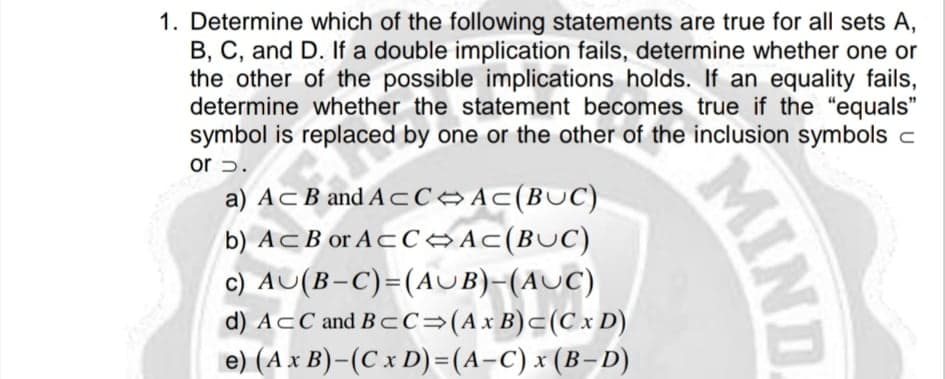a) Ac B and A CC→AC(BUC) b) AcB or AcC→Ac(BUC) c) AU(B-C)=(AUB)-(AUC)
Elementary Geometry For College Students, 7e
7th Edition
ISBN:9781337614085
Author:Alexander, Daniel C.; Koeberlein, Geralyn M.
Publisher:Alexander, Daniel C.; Koeberlein, Geralyn M.
ChapterP: Preliminary Concepts
SectionP.1: Sets And Geometry
Problem 12E: For the sets given in Exercise 9, is there a distributive relationship for intersection with respect...
Related questions
Question

Transcribed Image Text:1. Determine which of the following statements are true for all sets A,
B, C, and D. If a double implication fails, determine whether one or
the other of the possible implications holds. If an equality fails,
determine whether the statement becomes true if the "equals"
symbol is replaced by one or the other of the inclusion symbols c
or 5.
a) AcB and A CCAC(BUC)
b) Ac B or AcC→Ac(BUC)
c) AU(B-C)=(AUB)-(AUC)
d) AcC and B- C=(Ax B)c(Cx D)
e) (A x B)-(C x D)=(A-C) x (B-D)
MIND
Expert Solution
This question has been solved!
Explore an expertly crafted, step-by-step solution for a thorough understanding of key concepts.
This is a popular solution!
Trending now
This is a popular solution!
Step by step
Solved in 3 steps with 1 images

Recommended textbooks for you

Elementary Geometry For College Students, 7e
Geometry
ISBN:
9781337614085
Author:
Alexander, Daniel C.; Koeberlein, Geralyn M.
Publisher:
Cengage,

Elementary Geometry for College Students
Geometry
ISBN:
9781285195698
Author:
Daniel C. Alexander, Geralyn M. Koeberlein
Publisher:
Cengage Learning

Elementary Geometry For College Students, 7e
Geometry
ISBN:
9781337614085
Author:
Alexander, Daniel C.; Koeberlein, Geralyn M.
Publisher:
Cengage,

Elementary Geometry for College Students
Geometry
ISBN:
9781285195698
Author:
Daniel C. Alexander, Geralyn M. Koeberlein
Publisher:
Cengage Learning